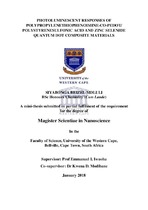| dc.contributor.advisor | Iwuoha, Emmanuel I. | |
| dc.contributor.advisor | Modibane, Kwena D. | |
| dc.contributor.author | Mdluli, Siyabonga Beizel | |
| dc.date.accessioned | 2018-08-16T13:10:27Z | |
| dc.date.available | 2018-08-16T13:10:27Z | |
| dc.date.issued | 2018 | |
| dc.identifier.uri | http://hdl.handle.net/11394/6320 | |
| dc.description | Magister Scientiae - MSc (Chemistry) | |
| dc.description.abstract | Research in renewable energy has gained momentum and become a centre of attention as a
possible alternative solution to the energy catastrophe. This is attained by the use of solar
energy as an alternative clean energy source. The creation of solar energy arises as a
consequence of direct conversion of light photons from the sun into electrical energy by the
use of solar cells made up of semiconducting materials incorporated into the system. In the
context of solar energy, hybrid photovoltaics comprising of organic molecules and
nanomaterials have emerged to be one of the most promising candidates to lower the cost of
construction of solar cells as well as improving the power conversion efficiency (PCE). This is
mainly due to the ease of processability of the active layer and the unique properties brought
by the use of nanomaterials. In the exponential increasing wide field of nanotechnology, focus
has shifted to novel hybrid dendritic star copolymers as the organic donor materials and
quantum dots as the inorganic acceptor materials. | |
| dc.language.iso | en | |
| dc.publisher | University of the Western Cape | |
| dc.title | Photoluminescent Responses of Polypropylenethiophenoimine-Co-Pedot/ Polystyrenesulfonic Acid and Zinc Selenide Quantum Dot Composite Materials | |
| dc.rights.holder | University of the Western Cape | |

